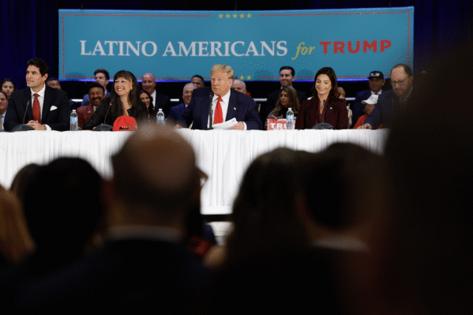Trump won Miami-Dade, once solidly blue, with significant support from Hispanics
Published in News & Features
MIAMI — For a third time in a row, Donald Trump grew his support among Latinos in Miami-Dade, becoming the first GOP presidential candidate in over three decades to win a Hispanic-majority county that was once solidly blue.
His vote share grew in practically every city in the county Tuesday night compared to when he first ran eight years ago, according to a Miami Herald analysis. That includes some of the heavily Hispanic strongholds such as Hialeah and Doral that gave him his highest shares of the county vote this election.
Trump lost Doral in 2016 and narrowly lost Hialeah that year as well. But he won a slim majority of voters in Doral in 2020 and more than two-thirds of voters in Hialeah that year. This time around, he won 63% of the vote in Doral and more 75% of the vote in Hialeah.
While Trump failed to win an outright majority of Hispanics nationwide, according to exit polls, he undoubtedly made meaningful inroads among Hispanic voters – especially men – underscoring a shift in an electorate that Democrats once saw as an increasingly reliable bloc for their party.
“The overwhelming numbers we’ve seen among Hispanic and Latino Americans, not just in Florida, but nationwide — it’s a sign that his message is resonating and the Republican message is resonating,” said Republican state Rep. Juan Carlos Porras.
Analysts have long described Florida Hispanics as an outlier in their support for Republicans. But Tuesday’s results reflect a political realignment among a broad swath of Hispanics who have previously not supported Trump.
After winning just 32% of the Hispanic vote nationwide four years ago, Trump captured 45% of the crucial electorate this year, exit polls show. The shift was even more apparent among Latino men; Trump won just 36 of those voters in 2020, but captured 54% in Tuesday’s election.
Miami-Dade was not the only majority-Hispanic jurisdiction to swing to Trump in the U.S. For instance, President Joe Biden won Cameron County, on the Texas-Mexico border, in 2020 with about 56% of the vote. This time around, Trump won the county with 53% of the vote.
Experts and voters say among the reasons for the shift are discontent with economic conditions during the Biden administration, widespread inflation, concerns over border security and public safety, and a Democratic Party whose messaging simply did not resonate.
Robert Asencio, a former Democratic legislator in Tallahassee, told the Herald that the leadership of the state and local Democratic Party “must take a look at itself.” He said that Tuesday’s results were the outcome of Democrats not investing resources or people in Florida.
“Republicans have gained greater benefit and greater results because they have invested in this year-round machinery of communication,” said Asencio.
Trump made a concerted effort to reach out to South Florida’s Hispanic voters, raising eyebrows from analysts who questioned why he spent much time in a state he was almost guaranteed to win during an election that would boil down to a handful of swing states, like Georgia, Pennsylvania and Wisconsin.
He held rallies, town halls and roundtable discussions in Doral in the months and weeks leading up to the election, many of which were geared toward reaching Latinos, not just in Florida but nationwide.
Meanwhile, his Democratic rival, Vice President Kamala Harris, never once paid a visit to Florida during her presidential campaign, opting instead to dispatch a series of surrogates to the state to meet with donors.
Trump gains among non-Hispanics in Dade
It wasn’t just heavily Hispanic areas in Miami-Dade where Trump saw a rise in support.
His vote share increased dramatically in heavily Black Miami Gardens compared with 2016, when he won only 7% of the vote, and 2024, when he won nearly 24% support in the city.
And while he narrowly lost the vote in the city of Miami, his share of the vote in the city increased dramatically across all three elections.
But in majority-Hispanic Miami-Dade County, it’s the Hispanic vote that stands out – and could offer clues about the future political loyalties of the country’s growing and powerful Hispanic communities.
Mike Madrid, a Republican strategist and co-founder of the anti-Trump Lincoln Project, said that if the exit polling numbers on Hispanic voters are accurate, it was the second presidential race in which a “historic share” of Latinos gravitated towards the GOP.
“It’s part of a broader generational shift we’ve been witnessing for over a decade and expect it will continue as younger third generation Latinos become a larger share of the country’s Latino voters.”
_____
©2024 Miami Herald. Visit miamiherald.com. Distributed by Tribune Content Agency, LLC.







Comments